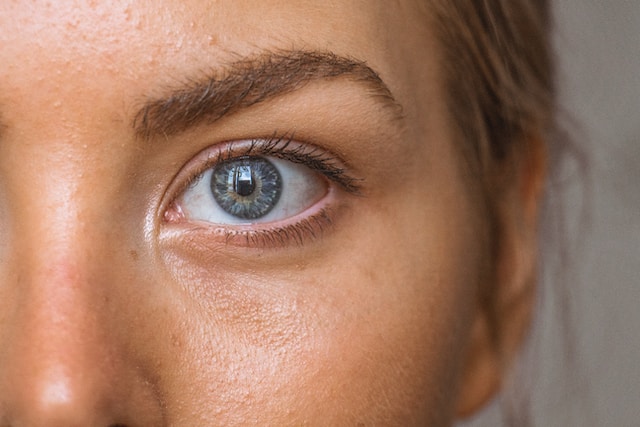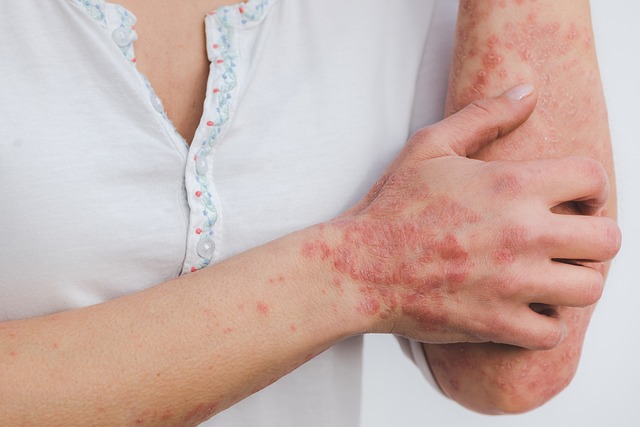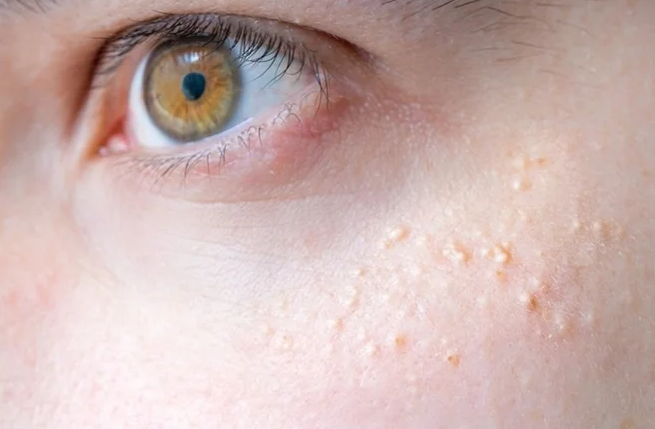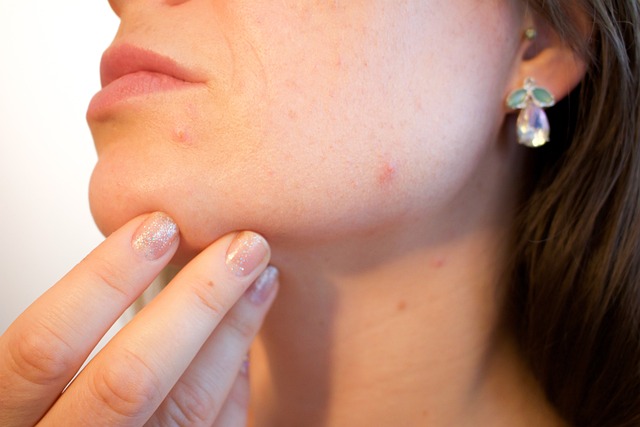Milialar Skin Disease | Causes, Symptoms, Treatment, and Precautions

A non-life-threatening skin disease is Milialar. But we have to be aware of this disease to avoid irritation and discomfort. Let us try to know the actual causes, its symptoms, and also the remedies for a healthier life.
What is Milialar?
Milialar (Singular: milium) is a non-life-threatening skin disease. These are small white or yellowish cysts or bumps that appear commonly on the surface of the skin.
It is also referred to as “milk spots” or “oil seeds”.It is mainly found around the eyes, nose, cheeks, and even on the forehead. But it can appear anywhere on the body. It can occur in people of all ages, from newborns to adults. Normally, it is painless and harmless. But some people with sensitive skin may need preventive measures for the same.
Why do we have to know about Milialar?
Although Milialar is a painless and harmless skin disease, but also to avoid any discomfort, anxiety, and hesitation regarding short-span side effects of this skin disease, we must be aware of the products used and about different daily activities mentioned below—–
1. Skin Care and Prevention:
There may be a risk factor for a more informed approach to skincare. People are taking more proactive steps to avoid Milialar, such as sun exposure and the use of specific skincare products.
2. Age and sense-related issues of people:
This skin disease may occur on the skin of people of any age. But it will disappear after some days. There is no need to be worried about it. Any anxiety to be reduced and self-confidence to be increased by a clear understanding that Milialar is frequent and curable.
3. Effect of using cosmetics:
Most people have a tendency to use different types of cosmetics which have an impact on their personal look. A proper understanding of Milialar enables people to notice and successfully handle these aesthetic issues.
4. Consultation with Dermatologist:
In most cases, consultation with a Dermatologist is not required. It’s true that Dermatologists are skilled in diagnosing Milialar correctly by identifying their type and offering advice and necessary treatment based on particular skin and conditions. Those people who have more sensitive skin can consult with a dermatologist.

Different Types of Milialar:
Based on their origin and location, there are three different types of Milialar observed.
- Primary
- Secondary
- Neonatal
1. Primary Milialar:
The primary type of this disease develops when dead cells become trapped just beneath the surface of the skin. The most common type of Milialar is often seen on the skin of the child. It is also known as “Milialar en plague” which is associated with other skin disorders.
2. Secondary Milialar:
It can form after injuries to the skin such as burns or after using steroid creams. It can occur at any age and is usually associated with damage to the skin.
3. Neonatal Milialar:
This type of skin disease is harmless and usually disappears on its own. These are tiny white bumps. These commonly appear on a newborn’s face and nose.
Causes of Milialar:
The primary causes of the formation of this disease are described below—
1. Sun damage / Sun exposure:
The skin will be more thicker for prolonged sun exposure. As a result, the skin will be harder increasing the risk of this skin disease. Ultraviolet radiation can damage the skin. It increases the production of keratin (a protein that is found in the skin, nails, and hair) which in turn increases the risk of skin disease.
2. Skin care products:
The use of heavy and oily skin care products can lead to the damage of skin cells. This may lead to the development of this skin disease. Particularly, the steroid creams may cause this skin disease as a side effect.
3. Genetics:
Some people may have a genetic problem. Mutations in genes can alter how fat is processed in the liver and may also cause this disease. A family history of it can increase this problem occurring.

Symptoms of Milialar:
There are so many symptoms that can give us information about this skin disease.
- Redness: Using rough sheets or cloths may cause milia to appear red and more irritated. So avoid using rough clothes or sheets if your skin is more sensitive.
- Itching and pain: Itching on the whole body might be the symptom of an underlying illness
- Swelling: It is the enlargement of organs, skin, or other body parts.
- Painless Bumps: It is one kind of cyst formed under the skin and does not create any pain.
Treatment and Therapy of Milialar:
There is no need to treat infants who are affected by skin disease. This problem will disappear within a few weeks. It will go away within a few months for older children and adults. There are some treatment procedures for these cysts that cause discomfort for more sensitive skin.
- A sterile needle can pick out the contents from cysts. This treatment process is called “Deroofing”.
- Vitamin-A-containing cream “Topical retinoids” can help to prevent this disease.
- A small laser treatment can be used to rid of the cysts.
- Heat treatment can be applied to prevent the cysts.
- Surgically we can remove the cysts after consulting with the Dermatologist.
A Dermatologist or other specialist healthcare provider can diagnose this disease. Self-diagnosis is discouraged as various skin disorders might be fatal for sensitive skin. Actually, skin specialists can scrutinize the size, color, and form of the lumps. They can undertake a comprehensive visual examination of the skin. A precise diagnosis is needed for individualized treatment of this disease.
Precautions:
Some primary precautions are to be taken to prevent this skin disease –
1. Avoid the following ingredients, if you have milia-prone skin–
- Paraffin oil
- Petroleum oil
- Liquid paraffin
- Liquid petroleum etc.
2. Clean the affected area with a gentle, paraben-free soap.
3. Wash on a regular basis with lukewarm water after applying some soft skin protective cream may help to keep away from this disease.
Some Tips to care for your Skin:
Some important tips have been mentioned below for your skin for all seasons.
- Wash your face every day in the evening. Particularly after reaching home from your workplace.
- Always use lukewarm water for cleaning your face and also for bathing.
- Always use a soft cloth and avoid harsh scrubs. Otherwise, it can cause skin irritation.
- Exfoliate a few times per week very cautiously.
- Wear sunscreen to protect the skin from UV rays
- If you have long hair, wash it regularly to make it oil-free.
- Always clean your mobile phone, sunglasses, etc. to get rid of oil.
- Try to use oil-free makeup. If you wear makeup, wash your skin regularly.
- Wash makeup brushes and sponges whenever you use it
- Never share makeup, brushes, or sponges with others.

Milialar at a glance:
| Size | Small pinhead-sized, Typically 1-2 mm |
| Shape | Dome-shaped |
| Color | White or yellowish |
| Texture | Cysts or Bumps or pimples |
| Location | Most commonly found beneath the eyes, on chicks, or on the forehead |
| Appearance | Tiny pearl or sand particle |
| Dermatological effect | Harmless. No serious effect on the skin of children. Only some irritations may occur on the skin of an aged person and also on more sensitive skin. |
Conclusion:
It’s true that Milialar is a skin disease. But it is not harmful or painful to most of the people. Particularly in the case of a child, this problem will automatically be removed after some days. Medical attention is not required for most of the cases. It can cause discomfort or irritation to some people with more sensitive skin. Their skin problem can be solved easily after consulting with the Dermatologist.
Frequently Asked Questions:-
What are the ways to get rid of milialar?
There are some preventive measures to get rid of this skin disease —
Sunshield to prevent UV rays
Avoid heavy oils
Gentle Cleaning
Choose an acne-protected product
Routine shedding or exfoliation.
When do you consult with Dermatologist for Milialar?
Milialar is a harmless skin disease. But if all other removal methods fail to clear up cysts, it may be time to make an appointment with a Dermatologist to consult.
Is there any home treatment to prevent Milialar?
Gentle exfoliation and an adequate skincare regimen can help to protect against this skin disease. Also washing on a regular basis with some soft skin protective cream may help to keep away from this disease.
Related post:



